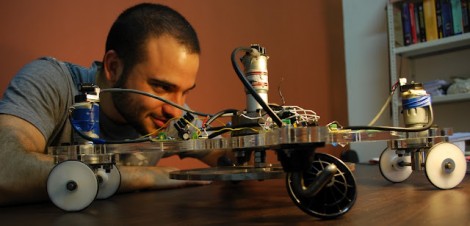
This robot uses the concept of a snakeboard for getting around. [Sevag Babikian] built the project, and has gone out of his way to explain how it works.
We’d recommend skimming over his explanation, but it was the video after the break that made all things clear to us. There is a large fly-wheel at the center. This is not continuously rotating, but oscillates a few inches in either direction. This inertial change shifts the center of gravity for the entire frame, causing motion. By oscillating the front and rear axles at the appropriate time the beast can move forward in a surprisingly straight line.
It’s doing this with just three motors. [Sevag] speculates that with further testing and refinement this could be a very efficient way to move the bot around. We have our doubts about that, but we are mesmerized by the undulations and how well they really do propel the thing along.















Hmm, the first advantageous application that comes to mind is an ice-skating bot. (no fans)
That thing reminds me of the little toys from Wham-O in the 90s where you sit on them and swivel the steering back and forth to move forward.
Oh, and ur fired again, Mike. It leverages ‘inertial’? Inertial==Adjective; Inertia==Noun
I was wondering: What’s an inertial for?
I’m interested in knowing a method for locomotion that doesn’t leverage inertia. ;)
It doesn’t shift the center of gravity. It applies a YAW torque. Depending which way the wheels are turned, the torque is either transferred into the ground as friction, or allowed to YAW the robot.
In other words, at least half of the energy put into this system is absorbed by friction. This makes it highly inefficient. It’s clever though.
Also, rotating bodies don’t rotate in inches, they rotate in degrees.
While your first point is right. About applying a torque, and not shifting center of gravity, your second, about the energy loss is incorrect.
Energy is force*distance, and since it aint moving when you suppose that its losing energy, there aint no distance for the energy to be lost.
Im not saying that it IS efficient, but your reasoning is incorrect.
Also, Mike, English well you speaks.
I’m curious – could this be done with a single motor? Link the “steering” wheels to the “drive” wheel via chain, and put a simple servo that adds or subtracts additional rotation to the “steering” wheels as needed. All the power would come from a single motor this way.
Guru, very likely. If you setup a very light weight crank system like a car engine to time the movements. However, with one motor/pattern, you will likely only be able to go straight forward/backward. Or do the zoolander, where backwards also turns you one direction.
What in the world would be efficient about this? Just the fact that the motor does not continuously rotate? Isn’t the start of rotation of a DC motor the point in which it draws the most current (or when friction becomes so great that the motor stalls, of course)? There are still two motors moving the flywheels, so it wasn’t a reduction in the number of motors. And if you are pulsing one motor on and then the other, wouldn’t that pretty much be the same as running just one continuously?
I would read the article to see if it answers my questions, but I have a strong feeling it just doesn’t wash.
I wonder if the mechanic’s creeper casters help or hinder this?
The design of those casters is near 100 years old and they’ve had the same flaw since the day they were first made. They induce a motion at an angle to the direction of force applied. Ie, when you’re laying under a car on one and want to push straight toward your head, the bleeping thing will veer off to one side and slam you into a jack stand.
The sole reason they exist is to fit a large diameter wheel into a lower height.
Surprising that in all the years since that angled caster wheel was designed, nobody has bothered to correct its problems so it’ll push straight.
It’s all fun and games till someone has to make a u-turn.
I have to say, that this particular project seems the less interesting one within the others placed on DepotBassam.com. Anyway it is always cool to see something that different from standard 4-wheel rig.
BTW: Had anyone seen a project basing its steering system on changing point of the mass (just like skateboarders do)?
Ok, now try to climb a slope. Thought so.
I can honestly see no good outcomes from this. Maybe movement on ice but this whole contraption is like a square wheel. Altough square wheels have some uses.
Actually it can, snakeboard are knows to be able to go up hills. The video you see shows the system running at 11 volts, while it was designed for 18 Volts. Increasing the voltage would of course increase velocities and accelerations, and the robot can be pretty much faster. Oh, and the steering angles used were not optimized here in the video. Cheers anyway and thanks for commenting everyone. Enjoy
People, there is an instructable for this robot I posted here: http://www.instructables.com/id/The-ShakerBot/